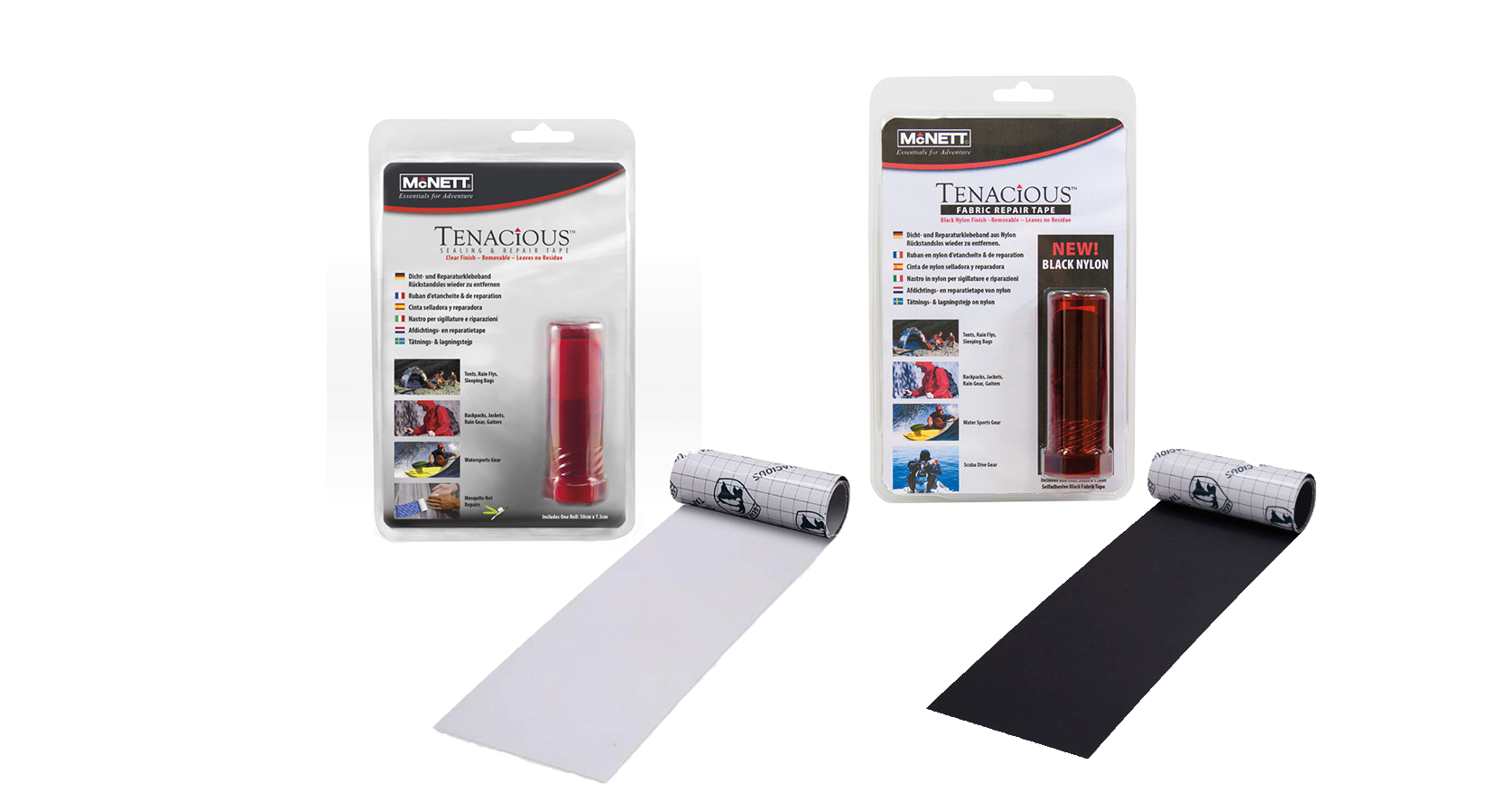A good repair kit deals with both freak disasters — a fire in a tent, an avalanche, a broken backpack frame — and damages that occur on every expedition, like rips that need a sturdy sewing job. You can’t carry a garageful of tools into the field but you need to be able to repair almost everything. Achieving this in a light, compact kit is the challenge.
A repair kit changes with place and style of travel: Sea kayaking needs different tools and materials than mountaineering or pulling a sled across Antarctica. But many common items figure on almost every wilderness deep-dive.
Below, we consider some of the tools and products in an all-purpose repair kit. Rather than a complete list, it offers ideas. This is, in the main, a summer inventory, though some items are all-season. We’ll cover a kit specifically for winter in a future post.
Adhesive Tapes:
- Duct tape was one of the few positives to come out of World War II. It’s sometimes called duck tape, because the original backing was a heavy waterproof cotton known as duck cloth. Myths have grown up around this hyper-indispensable item, such as the tale of the Alaskan fisherman who allegedly used it to repair his light aircraft after a bear tore a hole in the side. No need to tote a full roll, unless you’re sea kayaking or canoeing, and the watercraft bears the burden. It wraps nicely around water bottles and trekking poles. You can even buy mini one- to five-metre rolls. The only snag with duct tape and most other adhesives is that they’re useless in the cold: Water-based glue freezes and loses its stick.
- Spinnaker tape, originally intended for lightweight nylon sails, patches a variety of light- to medium-weight synthetics, including many coated nylons. However, it does not stick on slippery nylon with a DWR finish. It is a higher quality version of what is sometimes sold as ripstop tape.
- McNett Tenacious Tape is a weatherproof tape for rips and is a long-term solution, compared to duct tape, which is a stopgap. Dupont’s Tyvek Tape has even burlier bonding properties and can fix inflatable boats, including a packraft shredded by a grizzly bear.

McNett Tenacious Tape.

Duct tape wound around a liquid fuel gas bottle. The tape also serves to make the fuel bottle less conspicuous to cautious customs officers in airports or at borders. Snoopy loops, which are made from old car tyre inner tubes, are secured around it for spares and are useful for securing a rolled-up tent. Photo by Matthew Traver
Liquid Adhesives and Sealants:
- McNett’s Seam Grip is the best-known brand of liquid seam sealant for outdoor equipment. Aside from its basic use on tent fly seams, it plugs small holes in items like Thermarests. Liquid seam sealants need time to cure and are not ideal for quick repairs. Silicone products or silicone-treated nylon take a slightly different sealant, such as McNett SilNet or Stormsure.
- For a quick-setting adhesive, a small tube of Superglue — industrially known as a cyanoacrylate — won’t add much weight. As with duct tape, it issued from a War World II research project, in this case, the search for a clear plastic for gunsights. Later, army medics discovered that it sealed minor wounds. In the Vietnam war alone, a cyanoacrylate spray saved two dozen lives.

Copious amounts of seam grip were layered onto this inflatable mattress to seal up a cluster of micro-holes. Finding the punctures required putting it into a pool of water and looking for bubbles.
Photo by Matthew Traver
Putties:
- Putty is an oft-overlooked repair item. One brand, Sugru, resembles modeling clay. Once out of the packet, you have 30 minutes to mold it before it cures into a semi-flexible rubber. Aside from bonding broken fittings together, it lets you hack your equipment to better suit your needs: mounting a GoPro, embedding magnets onto headlamps or bike lights so they attach to a helmet, and glossing over rub points on boots.

Once cured, Sugru holds up to 2kg. Photo by Sugru

A cold shoe camera mount molded to the top of a trekking pole with Sugru. This field modification turns the trekking pole into a camera monopod and GoPro selfie stick. Photo by Matthew Traver
Fabrics & Webbings:
- Sheets of spare nylon will patch large tears or gaping holes in fabric. On long expeditions, a square of neoprene or foam serves as extra padding on waistbelts or shoulder straps that have flattened out from compression fatigue.
- A couple of short lengths of 12mm or 25mm nylon webbing, drafted as compression straps, will condense packing volume. They can also reinforce stress points on harnesses, waist belts and so on.

After a voracious pig in Chongqing, China, munched through the adjustment webbing on a waist belt, two lengths of black 25mm webbing were sewn in place.
Photo by Matthew Traver.
Cord & Wire:
- Every repair kit needs a few meters of utility cord in several diameters. 3mm cord, for example, can lash together two broken pieces. Jellies or putties are then applied to keep the cord from slipping. Thicker cord becomes an extra guyline for a tent in a gale. Medium-diameter: Everything from a drawstring to a shoelace to a zipper pull. (Any zipper that does not have a hole for a cord if the tab breaks — a common occurrence, especially on cold-weather trips — should not be brought on an expedition.)
- Thin galvanized steel wire — either snare wire or from a craft shop — isn’t often used, but it can join parts that rub too much for cords. Heated wire also melts neat holes in plastic, then the wire itself serves heavy-duty stitches for items under serious stress.

An intimate look at the author’s grubby synthetic belay jacket patched with spinnaker tape. Extra long lengths of 3mm cord were added to the zipper tabs for easier operation with gloves.
Photo by Matthew Traver.
Tools:
- Most kits include a small multitool, such as a Leatherman or Swiss Army knife. You’re looking, in particular, for screwdrivers that match any screws on your gear, a hacksaw and a basic blade (for cutting open freeze-dried packages, for example). Scissors on these units tend to be flimsy, and small folding models, available on the odds-and-ends rack of many camping stores, are preferable. A lightweight hacksaw with a two-inch blade can also be custom-made.
- Tools specific to an expedition’s gear might include some Allen keys (for dismantling a gun in polar bear country) or a jeweler’s screwdriver for eyeglasses or iPhones. Part of the art of assembling a wilderness kit is figuring out how to modify midweight, bulky tools into peanut-sized featherweights. For example, weld an O-ring onto the shaft of a Phillips screwdriver head for adequate torque. You can do the same with an awl.
- Alcohol swab packets remove dirt and prep fabric for adhesives. A square of sandpaper likewise readies a surface for bonding. Silicon carbide paper works best with plastic and metals; aluminum oxide paper for wood.
- A couple of drill bits wrapped in cloth tape will bore a hole in wood or metal, if, for example, your paddle snaps at the joint and you need to pin it together with a bolt. Without an actual drill, it will take time and patience, but for this once-in-a-blue-moon repair, it is not worth carrying a drill for 10 years.
- A good sewing kit is one of the most vital ingredients: strong nylon thread, needles (round shafts for thinner fabric, triangular shafts for thick material), a thimble and small needlenose pliers to pull the needle through heavy fabric. If you’re a Russian climber, you can even suture up your leg with a needle and thread. Many outdoor brands offer all-in-one kits, but most contain unnecessary filler, such as a stitch picker. You can use the tip of a sharp knife or a scalpel blade instead. If a bear gashes open your tent and you run short of thread during the day-long repair, dental floss or fishing line will save the day.

A LOWA Desert Elite boot showing a fabric panel above the midsole that was hand stitched and seam gripped in the Central Asian steppe. The toe was also filled in with seam grip on location after it began to tear away from the rand allowing grit to rub away the glue attaching the sole.
Photo by Matthew Traver






